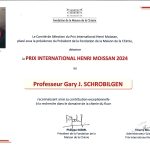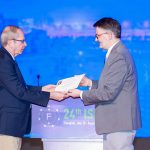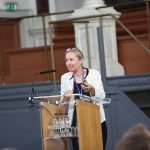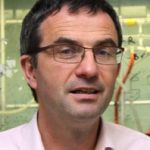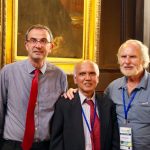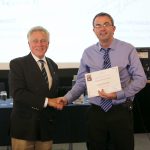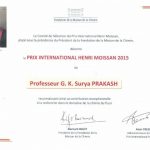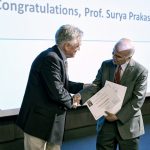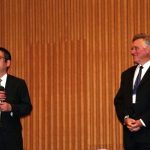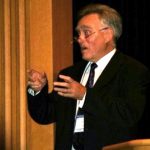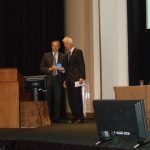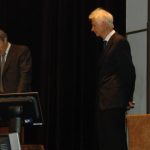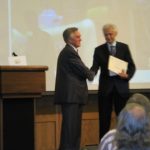Le Prix 2024
Professeur Emérite de chimie à l’Université McMaster (Hamilton, Canada), Gary J. SCHROBILGEN est le lauréat 2024 du Prix International Henri Moissan pour ses travaux en chimie du fluor et, en particulier la chimie du fluor inorganique, la chimie des gaz rares, la chimie des groupes principaux et des métaux de transition, et la radiochimie. Son domaine de recherche a de nombreuses applications dans la production d’énergie nucléaire, les matériaux photovoltaïques et semi-conducteurs, les réfrigérants, les propulseurs avancés de fusée, et la microélectronique. Le Professeur Schrobilgen a également appliqué ses recherches à des problèmes pratiques liés à l’imagerie médicale, au cycle de réenrichissement de l’uranium et aux matériaux à haute densité énergétique.
Le Professeur Gary J. Schrobilgen recevra des mains de Monsieur Philippe Gœbel, Président de la Fondation de la Maison de la Chimie et Président du Comité Scientifique du Prix Moissan, la médaille Moissan 2024, spécialement conçue pour cette occasion, lors d’un symposium organisé le 5 novembre 2025 à Paris (France) par la Fondation de la Maison de la Chimie.
Il est intervenu au 24ème Symposium International sur la Chimie du Fluor qui s’est déroulé en juillet/août 2024 à Shanghaï (Chine).
Gary J. Schrobilgen, originaire de l’est de l’Iowa, a obtenu son baccalauréat en chimie du Loras College (Dubuque, Iowa), sa maîtrise en chimie inorganique de l’Université Brock (St Catharines, Ontario, Canada) et a effectué ses recherches doctorales en chimie inorganique à l’Université McMaster sous la direction du Professeur Ronald J. Gillespie. Le Professeur Schrobilgen a été boursier postdoctoral du Conseil de Recherches en Sciences Naturelles et en Genie (CRSNG) du Canada à l’Université de Leicester (Royaume-Uni), et s’est joint au département de chimie de l’Université McMaster en tant que chercheur universitaire du CRSNG et membre du corps professoral en 1980, avant d’être promu Professeur titulaire de chimie inorganique en 1988.
Il a apporté d’importantes contributions dans deux domaines majeurs de la chimie inorganique synthétique et structurale ; chimie des métaux fluorés du groupe principal et de transition et anions Zintl polyatomiques des éléments du groupe principal. Les deux programmes s’appuient fortement sur l’utilisation de méthodes modernes d’élucidation structurale, notamment la spectroscopie multi-RMN, la cristallographie aux rayons X et la spectroscopie vibrationnelle, ainsi que les calculs de chimie quantique, pour caractériser de nouvelles caractéristiques de liaison entre des éléments du groupe principal et de transition dans leurs états d’oxydation les plus élevés. Il est surtout connu pour ses travaux dans le domaine expérimental exigeant et difficile de la chimie inorganique du fluor, englobant les synthèses et la caractérisation structurale d’un grand nombre des composés connus du krypton et du xénon ainsi que des dérivés fluorés et oxofluorés des éléments du groupe principal et de transition dans leurs états d’oxydation les plus élevés et aux limites de coordination. Il est également connu pour ses travaux dans deux domaines de la radiochimie, qui impliquent la synthèse de composés fluorés du 99Tc pertinents pour le cycle du combustible de l’uranium, et de produits radiopharmaceutiques marqués au 18F utilisés dans l’imagerie TEP (tomographie par émission de positrons) du cerveau humain. Ses travaux fondamentaux ont joué un rôle important dans notre compréhension de la structure et des liaisons chimiques dans les molécules dites « hypervalentes » et dans les anneaux, cages et clusters des éléments du groupe principal. Quelques exemples notables de composés synthétisés et caractérisés, pour la première fois, par le Professeur Schrobilgen et son groupe de recherche à McMaster comptent: l’oxyde de Xe(IV), XeO2, les fluorures d’oxyde de Xe(II), O(XeF)2, [FXeOXeFXeF]+ et [XeOXeOXe]+, le complexe cinétiquement stable de XeO3, (CH2CH2O)5XeO3, le cation, [RCNKrF]+ (R = H, CF3, C2F5, C3F7) et les premiers composés mixtes krypton/xenon, e.g., [FKrFXeF]+, [F5Xe(FKrF)n]+ (n = 1, 2). Beaucoup de ses composés sont désormais des exemples de manuels.
Une autre des caractéristiques du Professeur Schrobilgen est son approche pratique de la formation des cycles supérieurs et des premiers cycles en chimie inorganique expérimentale. Il est récipiendaire du Prix du Président pour l’excellence en supervision d’études supérieures à l’Université McMaster (1997).
Parmi les autres prix et distinctions reçus par le Professeur Schrobilgen figurent: le prix de l’American Chemical Society (ACS) pour son travail créatif en chimie du fluor (1998) ; le prix pour service remarquable de la division chimie du fluor de l’American Chemical Society (2021); la médaille Blaise Pascal en chimie de l’Académie Européenne des Sciences (2022); plusieurs prix de la Société Canadienne de chimie: le prix de conférence Alcan (2002), le prix de chimie pure ou appliquée (2002), le prix E. W. R Steacie en chimie (2003), le prix Thirty from the Past Thirty (reconnaissant l’excellence parmi les anciens diplômés de l’Université Brock) et a été titulaire d’une bourse de recherche Killam du Conseil des Arts du Canada (1998-99). Il a été élu membre de la Société Royale du Canada en 1999, membre de l’American Chemical Society en 2013, et membre le l’Académie Européenne des Sciences en 2022.
Le professeur Schrobilgen a siégé au comité exécutif de la division de chimie du fluor de l’American Chemical Society (2002-2026) et a aussi occupé les postes de vice-président/secrétaire (2002-2004), président (2005) et ancien président de la Division du fluor (2006) au cours de cette période. Il a aussi reçu un Humboldt Forschungspreis (Prix de recherche) de la Fondation Alexander von Humboldt, le Distinguished Alumni Award in the Sciences de l’Université McMaster (2011), le Lifetime Achievement Award in Fluorine Chemistry parrainé par SciFluor (2012) et le Distinguished Mathematics and Science Alumni Award de l’Université Brock (2014). Sa carrière a été honorée lors d’un symposium spécial intitulé, “Exploring the Frontiers of Fundamental and Applied Fluorine Chemistry” lors du 248eme National Meeting ACS, San Francisco, California, Aug. 10−14, 2014. En 2017, il a été choisi pour délivrer la “Neil Bartlett Lectureship in Inorganic Chemistry”, Université de Californie, Berkeley.
The 2024 Prize
Professor Emeritus of Chemistry at the McMaster University (Hamilton, Ontario, Canada), Gary J. SCHROBILGEN is the 2024 laureate of the International Henri Moissan Prize for his work in fluorine chemistry, and in particular inorganic fluorine chemistry, noble-gas chemistry, main-group and transition-metal chemistry, and radiochemistry. His research field has numerous applications in nuclear power generation, photovoltaic and semiconductor materials, refrigerants, advanced rocket propellants and microelectronics. Professor Schrobilgen has also applied his fundamental research to practical problems around medical imaging, the uranium re-enrichment cycle and high-energy density materials.
Professor Gary J. Schrobilgen will receive from Philippe Gœbel, President of the Fondation de la Maison de la Chimie and Chair of the Moissan Prize Scientific Committee, the 2024 Moissan medal, which is specially made for the occasion, on November 5, 2025 during a symposium organized in Paris (France) by the Fondation de la Maison de la Chimie. He will also deliver a lecture at the 24th International Symposium on Fluorine Chemistry due to take place in Shanghai (China) in July/August 2024.
Gary J. Schrobilgen, a native of Eastern Iowa, received his BSc degree in chemistry from Loras College (Dubuque, Iowa), an MSc degree in inorganic chemistry from Brock University (St Catharines, Ontario, Canada), and carried out his PhD research in inorganic chemistry at McMaster University under the supervision of Professor Ronald J. Gillespie. Professor Schrobilgen was a Natural Science and Engineering Research Council (NSERC) of Canada Postdoctoral Fellow at Leicester University, U.K. and joined the McMaster University Chemistry Department as an NSERC University Research Fellow and member of faculty in 1980 and was promoted to full Professor of Inorganic Chemistry in 1988.
He has made important contributions in two major areas of synthetic and structural inorganic chemistry; main-group and transition metal fluorine chemistry and the polyatomic (Zintl) anions of the main-group elements. Both programs are heavily reliant upon the use of modern methods of structural elucidation, including multi-NMR spectroscopy, X-ray crystallography and vibrational spectroscopy, as well as quantum-chemical calculations, to characterize novel bonding situations among main-group and high-oxidation state transition element species. He is best known for his work in the experimentally challenging field of inorganic fluorine chemistry, encompassing the syntheses and structural characterizations of a large percentage of the known compounds of krypton and xenon as well as fluoro- and oxofluoro-derivatives of the main-group and transition elements in their highest oxidation states and at the limits of coordination. He is also known for his work in two areas of radiochemistry, which involve the syntheses of 99Tc fluorine compounds that are relevant to the uranium fuel cycle, and 18F-labelled radiopharmaceuticals of use in PET (positron emission tomography) imaging of the human brain. His fundamental work has been of importance in our understanding of structure and chemical bonding in so-called “hypervalent” molecules and main-group ring, cage, and cluster species. Among some of the notable chemical species, Professor Schrobilgen and his research group at McMaster University have synthesized and structurally characterized for the first time are: the Xe(IV) oxide, XeO2, the Xe(II) oxide fluorides, O(XeF)2, [FXeOXeFXeF]+, the [XeOXeOXe]+ cation, the kinetically stable complex of XeO3, (CH2CH2O)5XeO3, the krypton-nitrogen species, [RCNKrF]+ (R = H, CF3, C2F5, C3F7) and examples of isolable mixed krypton/xenon species, e.g., [FKrFXeF]+, [F5Xe(FKrF)n]+ (n = 1, 2). Many of his compounds are now textbook examples.
Another of Professor Schrobilgen’s trademarks has been his hands-on approach to graduate and undergraduate training in experimental inorganic chemistry. He is recipient of the President’s Award for Excellence in Graduate Supervision at McMaster University (1997).
Among other awards and recognitions Professor Schrobilgen has received are: the American Chemical Society (ACS) Award for Creative work in Fluorine Chemistry (1998); ACS Division of Fluorine Chemistry Distinguished Service Award (2021); European Academy of Sciences’ Blaise Pascal Medal in Chemistry (2022); several Canadian Society for Chemistry Awards: the Alcan Lecture Award (2002), the Award for Pure or Applied Chemistry (2002), the E. W. R. Steacie Award in Chemistry (2003), Thirty from the Past Thirty Award (Recognizing Excellence Among Brock University Alumni), and has held a Canada Council Killam Research Fellowship (1998-99). Professor Schrobilgen was elected a Fellow of the Royal Society of Canada in 1999, an ACS Fellow in 2013, and a Fellow of the European Academy of Sciences in 2022.
Professor Schrobilgen has served on the Executive Committee of the ACS Division of Fluorine (2002-2026) and has also held the positions of Vice Chair/Secretary (2002-2004), Chair (2005) and Past Chair of the ACS Fluorine Division (2006) during this period. He has also received a Senior Alexander von Humboldt Foundation Forschungspreis (Research Prize) (2010), the McMaster University Distinguished Alumni Award in the Sciences (2011), the Lifetime Achievement Award in Fluorine Chemistry sponsored by SciFluor (2012) and the Distinguished Mathematics and Science Alumni Award, Brock University, St. Catharines, Ontario (2014). He was honored by a special symposium entitled, “Exploring the Frontiers of Fundamental and Applied Fluorine Chemistry” at the 248th National ACS Meeting, San Francisco, California, Aug. 10−14, 2014. In 2017, he was chosen to deliver the “Neil Bartlett Lectureship in Inorganic Chemistry”, University of California, Berkeley.


